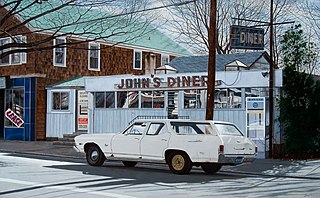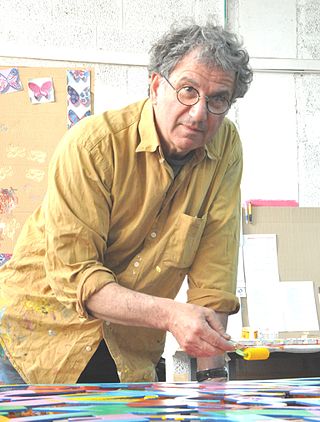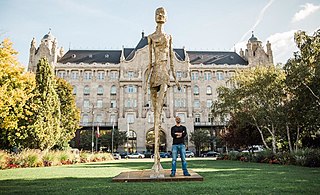
Photorealism is a genre of art that encompasses painting, drawing and other graphic media, in which an artist studies a photograph and then attempts to reproduce the image as realistically as possible in another medium. Although the term can be used broadly to describe artworks in many different media, it is also used to refer to a specific art movement of American painters that began in the late 1960s and early 1970s.
Denis Peterson is an American hyperrealist painter whose photorealist works have been exhibited at the Brooklyn Museum, Whitney Museum of American Art, Butler Institute of American Art, Tate Modern, Springville Museum of Art, Corcoran MPA, Museum of Modern Art CZ and Max Hutchinson Gallery in New York.
Mordechai Avniel (1900–1989), variant name Mordecai Avniel, was an Israeli painter, sculptor and lawyer.

Norbert Bisky is a German artist based in Berlin. He is one of the most important representatives of a new figurative painting in the 21st century.

Hyperrealism is a genre of painting and sculpture resembling a high-resolution photograph. Hyperrealism is considered an advancement of photorealism by the methods used to create the resulting paintings or sculptures. The term is primarily applied to an independent art movement and art style in the United States and Europe that has developed since the early 1970s. Carole Feuerman is the forerunner in the hyperrealism movement along with Duane Hanson and John De Andrea.

Yitzhak Frenkel, also known as Isaac Frenkel or Alexandre Frenel, was an Israeli painter, sculptor and teacher. He was one of the leading Jewish artists of the l’École de Paris and its chief practitioner in Israel, gaining international recognition during his lifetime.
Avner Ben-Gal was an Israeli international painter and artist, working mainly from Tel Aviv, Israel. His works depict various intense, often neglected locations such as agricultural fields, prisons and smoky interiors, whereby theatrical scenes play out. The scenes present ghostly, rough hewn and often low life figures that are bare and hardened. The parallel between Ben-Gal's raw way of painting and his tough, ambiguous subject matter allows a unique intensity within his paintings.

David (Dudu) Gerstein is an Israeli painter, sculptor, draftsman, and printmaker. He began as a figurative painter and was recipient of the Israel Museum Prize for illustration. At the end of the 1970s, he wished to expand the limits of two-dimensional painting, into painting in three dimensions. He began cutting out the main subjects of each painting and, to cancel the background, creating unique and iconic cutout images, free-standing in space, without the standard and traditional square frame.

Hillel Roman is a visual artist living and working in Tel Aviv, Israel.

Avraham Eilat is an Israeli artist, educator and curator. He graduated from the Hebrew Gimnasium Herzliya in Tel Aviv, and was enrolled in Hashomer Hatzair youth movement for nine years starting at age 9. After military service in 1960 he joined in Kibbutz Shamir, situated on the western slopes of the Golan Heights in the Upper Galilee, where he was a member until 1978. During his first years in the kibbutz, Eilat was a shepherd side-by-side with his kibbutz adopting father the painter Moshe Cagan. Close contact with nature and its phenomenon and the features of local landscape deeply influenced his way of thinking and established the themes appearing along all his career in his art. The contrast between man-made geometrical shapes of fish ponds and the free flowing of the flora and typical hilly landscape of the Hula Valley area, crystallized his visual language and determined its formal and thematic foundations. Avraham Eilat employs skillfully various means of expression: drawing and painting, etching, photography, sculpture, installation, and often a combination of more than one. Using those means enriches his basic statement and makes it complex and multi-layered. Avraham Eilat lives in Ein Hod Artists Village, Israel, with his spouse Margol Guttman, works in his studio in Pyramida Center of Contemporary Art, Wadi Salib, Haifa, and in his studio in Ein Hod.
Amnon David Ar is an Israeli painter. He studied at the Arts and Crafts Municipal High School of Tel Aviv until the age of eighteen. After completing his compulsory military service, he studied anatomy with Oswald Adler. He then spent one year at the Bezalel Academy of Arts and Design in Jerusalem, before leaving, because he felt that both the training and the curriculum didn't provide the skills and knowledge he was looking for. For this reason, Ar decided to organize his own studies, and spent a further year learning painting and drawing with Abraham Bykov. By studying with older artists, Ar has trained himself in a traditional way, and can, at least in part, be considered an autodidact. During his studies, Ar worked as a chief illustrator and caricaturist at Maariv and also at Yedioth Tikshoret. Today, Ar also teaches painting and drawing, with the express intention of passing on to the next generation of artists, his experience, and with it his understanding of the artistic skills of the past. In 2014 Ar moved to Berlin, where he has his studio and teaches.

Andy Denzler is a Swiss artist. His distinctive technique of distorting the freshly applied surface of his paintings has shaped his entire oeuvre in painting, printmaking, sculpture and drawing.
Daniel Enkaoua is an artist born in France but now an Israeli citizen.
Raphaella Beatrice Spence is a British photorealist and hyperrealist painter.
Mindy Weisel is an American abstract visual artist and author.

Angelika Sher is a Lithuanian-born Israeli photographer.
Shay Kun is an Israeli-American painter known for post-modern interpretation of the Hudson River School movement. He is the son of Israeli painter Zeev Kun.

Olaf Kühnemann is an Israeli-German painter, winner of the Isracard and Tel Aviv Museum of Art Prize of 2008, and was included in the juror's pick of the 2014 Thames & Hudson publishing's book, "100 Painters of Tomorrow". Since 2021 he is Co-Founder and Creative Director at Laba Berlin artist Fellowship program. Kühnemann lives and works between Berlin and Tel Aviv.
Lóránt Méhes is a Hungarian visual artist and painter. He has been involved with non-conformist visual art and alternative culture since the early '70s.

Eran Shakine is an Israeli artist, painter, illustrator and sculptor.











